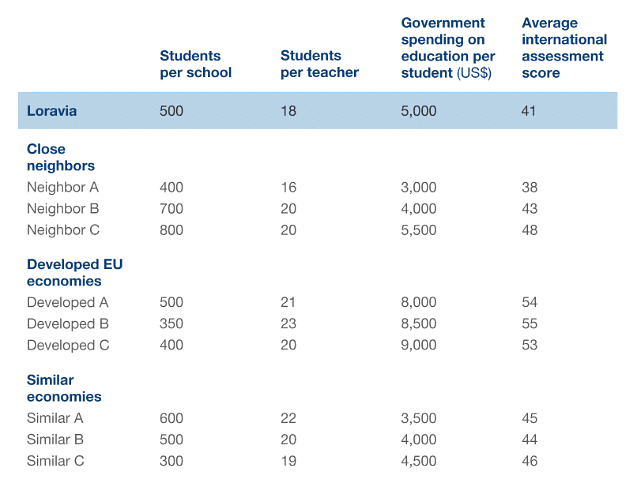National Education Case Interview | Case Studies - Interview Preparation PDF Download
Client goal
Loravia is a fictional country located in Eastern Europe with a population of 20 million. The government of Loravia wants to make major improvements in both the quantity and quality of education for its children. Because McKinsey has great deal of global knowledge and expertise in the education sector, the Loravian department of education has asked McKinsey to advise on how it can achieve this transformation of its school system.
Situation description
Loravia’s free market economy is still developing, having emerged from many decades under communism. Recently, the government of Loravia put a new economic plan in place with aspirations to transform its economy and turbocharge its development so it’s well positioned to compete with its European neighbors. The government of Loravia realizes that the education of its children is a critical factor in meeting crucial economic development goals. It intends to transform the school system over the next ten years to enable it to support its economic aspirations.
Schooling in Loravia is completely public and is provided by a network of government-run schools that admit children from ages five through 18.
The first stage of this effort will involve diagnosing the current state of education in schools in Loravia to determine how best to meet the government’s future aspirations.
McKinsey study
McKinsey has been asked to support the Loravian department of education in diagnosing the state of its current school system, and in identifying the most important areas for improvement.
Helpful hints
- Write down important information.
- Feel free to ask the interviewer to explain anything that is not clear to you.
Q.1. What issues would you want to investigate in diagnosing the current state of the Loravian school system?
When evaluating Loravia's education system, there are three main factors to consider:
(i) Access to education: It's important to examine who has access to education and how it differs by age, region, and demographic group. This includes analyzing the supply of teachers and education resources available at national, regional, and local levels, as well as the national, regional, and local budgets allocated for education.
(ii) Quality of education: The quality of education can be evaluated based on the curriculum being taught and the level of attainment or learning objectives for students. It's also important to consider the qualifications of teachers and the results of teacher assessments.
(iii) Economic objectives: It's important to consider Loravia's broader economic objectives and which industries and sectors will be a priority in the future. This includes evaluating the skills that will be needed and how well the current education system develops those skills. It may also be worth considering alternative models to a public education system, such as independent or private schools.
Q.2. The chart below shows some important education-related measures for Loravia and also for some comparison countries. Three sets of comparison countries have been used. The first set contains some of Loravia’s neighboring countries in Eastern Europe. In the second set are some of the most developed economies in Europe. Finally, in the third set are some countries that have similar sized economies to Loravia on a per person basis, which have similar GDP per capita.
What observations can you derive from this chart?

(i) Loravia spends more on education and has a lower student-to-teacher ratio compared to its neighbors and economic peers. However, despite these advantages, Loravia still has one of the lowest international assessment scores.
(ii) There seems to be no direct correlation between student-to-teacher ratio and education outcomes, as measured by international assessments.
(iii) Developed countries spend more per student on education and have better outcomes as measured by international assessments. However, among Loravia’s neighbors and peers, there is no clear relationship between spending and education outcomes.
(iv) While student-to-teacher ratios and per-student funding could be important in improving education quality, these factors alone may not deliver the necessary improvements. Other factors such as teacher quality and curriculum content should also be investigated to improve education outcomes in Loravia.
Q.3. One of the clients at Loravian’s educational department mentions neighbor country “C” as an example, because it’s outperforming all of Loravia's economic peers and neighbors in the international assessment. She believes that the more concentrated school structure in this country is a big reason for better outcomes in the international assessment. She suggests that having larger, less fragmented schools allows for more effective teacher selection and training, leading to improved education outcomes for students. Finally, she shares that 15 percent of Loravia's population is currently attending school.
What would be the reduction in the total number of schools in Loravia if it were to achieve the same average school size as neighbor country C?
(i) Loravia has three million schoolchildren
(ii) The current number of schools in Loravia is 6,000, with an average of 500 students per school
(iii) If the same school size as neighbor C is assumed, there would be 3,750 schools in Loravia
(iv) This would mean 2,250 schools would be closed if the number of schools in Loravia were reduced to match that of neighbor C
(v) The number of schools to be closed represents about 37.5 percent of schools in Loravia.
|
16 docs
|





















